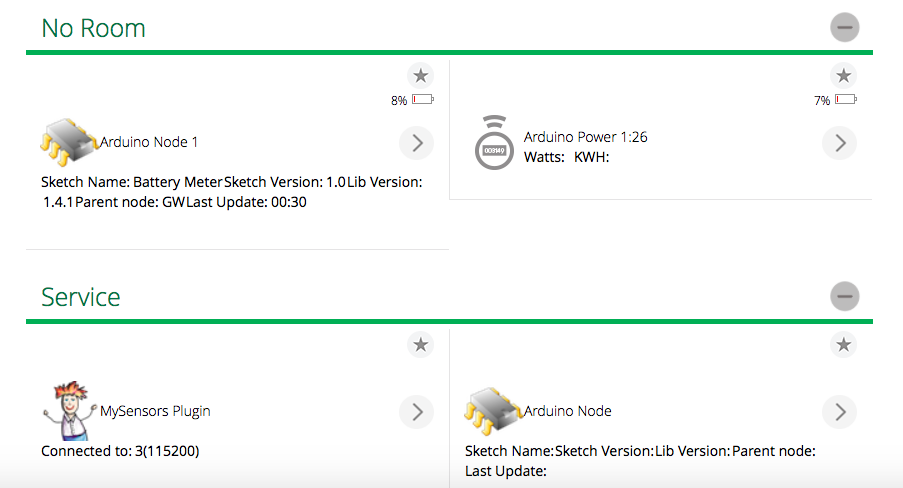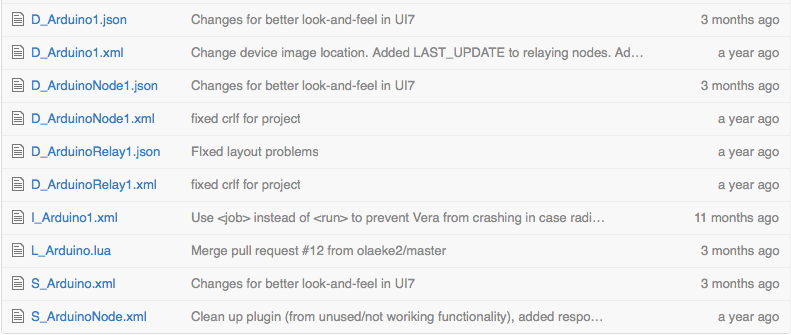Battery Sensor / Voltage Monitor
-
Guys,
This sketch compiled but doesn't work. I wondering if some one could have a look at it and see what I have done wrong. Cheers!
Serial Logs
sensor started, id 1
send: 1-1-0-0 s=255,c=0,t=17,pt=0,l=5,st=ok:1.4.1
send: 1-1-0-0 s=255,c=3,t=6,pt=1,l=1,st=ok:0
send: 1-1-0-0 s=255,c=3,t=11,pt=0,l=13,st=ok:Battery Meter
send: 1-1-0-0 s=255,c=3,t=12,pt=0,l=3,st=ok:1.0
send: 1-1-0-0 s=20,c=0,t=38,pt=0,l=5,st=ok:1.4.1
1023
Battery Voltage: 3.44 V
Battery percent: 102 %
send: 1-1-0-0 s=255,c=3,t=0,pt=1,l=1,st=ok:102// This is an example that demonstrates how to report the battery level for a sensor // Instructions for measuring battery capacity on A0 are available in the follwoing forum // thread: http://forum.micasaverde.com/index.php/topic,20078.0.html #include <SPI.h> #include <MySensor.h> #define CHILD_ID_BATT 20 int BATTERY_SENSE_PIN = A0; // select the input pin for the battery sense point MySensor gw; MyMessage msgBattery(CHILD_ID_BATT, V_VOLTAGE); unsigned long SLEEP_TIME = 900000; // sleep time between reads (seconds * 1000 milliseconds) int oldBatteryPcnt = 0; void setup() { // use the 1.1 V internal reference analogReference(INTERNAL); gw.begin(); // Send the sketch version information to the gateway and Controller gw.sendSketchInfo("Battery Meter", "1.0"); gw.present(CHILD_ID_BATT, V_VOLTAGE); } void loop() { // get the battery Voltage int sensorValue = analogRead(BATTERY_SENSE_PIN); Serial.println(sensorValue); // 1M, 470K divider across battery and using internal ADC ref of 1.1V // Sense point is bypassed with 0.1 uF cap to reduce noise at that point // ((1e6+470e3)/470e3)*1.1 = Vmax = 3.44 Volts // 3.44/1023 = Volts per bit = 0.003363075 float batteryV = sensorValue * 0.003363075; int batteryPcnt = sensorValue / 10; Serial.print("Battery Voltage: "); Serial.print(batteryV); Serial.println(" V"); Serial.print("Battery percent: "); Serial.print(batteryPcnt); Serial.println(" %"); if (oldBatteryPcnt != batteryPcnt) { // Power up radio after sleep gw.sendBatteryLevel(batteryPcnt); oldBatteryPcnt = batteryPcnt; } gw.sleep(SLEEP_TIME); } -
Guys,
This sketch compiled but doesn't work. I wondering if some one could have a look at it and see what I have done wrong. Cheers!
Serial Logs
sensor started, id 1
send: 1-1-0-0 s=255,c=0,t=17,pt=0,l=5,st=ok:1.4.1
send: 1-1-0-0 s=255,c=3,t=6,pt=1,l=1,st=ok:0
send: 1-1-0-0 s=255,c=3,t=11,pt=0,l=13,st=ok:Battery Meter
send: 1-1-0-0 s=255,c=3,t=12,pt=0,l=3,st=ok:1.0
send: 1-1-0-0 s=20,c=0,t=38,pt=0,l=5,st=ok:1.4.1
1023
Battery Voltage: 3.44 V
Battery percent: 102 %
send: 1-1-0-0 s=255,c=3,t=0,pt=1,l=1,st=ok:102// This is an example that demonstrates how to report the battery level for a sensor // Instructions for measuring battery capacity on A0 are available in the follwoing forum // thread: http://forum.micasaverde.com/index.php/topic,20078.0.html #include <SPI.h> #include <MySensor.h> #define CHILD_ID_BATT 20 int BATTERY_SENSE_PIN = A0; // select the input pin for the battery sense point MySensor gw; MyMessage msgBattery(CHILD_ID_BATT, V_VOLTAGE); unsigned long SLEEP_TIME = 900000; // sleep time between reads (seconds * 1000 milliseconds) int oldBatteryPcnt = 0; void setup() { // use the 1.1 V internal reference analogReference(INTERNAL); gw.begin(); // Send the sketch version information to the gateway and Controller gw.sendSketchInfo("Battery Meter", "1.0"); gw.present(CHILD_ID_BATT, V_VOLTAGE); } void loop() { // get the battery Voltage int sensorValue = analogRead(BATTERY_SENSE_PIN); Serial.println(sensorValue); // 1M, 470K divider across battery and using internal ADC ref of 1.1V // Sense point is bypassed with 0.1 uF cap to reduce noise at that point // ((1e6+470e3)/470e3)*1.1 = Vmax = 3.44 Volts // 3.44/1023 = Volts per bit = 0.003363075 float batteryV = sensorValue * 0.003363075; int batteryPcnt = sensorValue / 10; Serial.print("Battery Voltage: "); Serial.print(batteryV); Serial.println(" V"); Serial.print("Battery percent: "); Serial.print(batteryPcnt); Serial.println(" %"); if (oldBatteryPcnt != batteryPcnt) { // Power up radio after sleep gw.sendBatteryLevel(batteryPcnt); oldBatteryPcnt = batteryPcnt; } gw.sleep(SLEEP_TIME); }@jeylites From what I see the sketch is working fine except that it is reporting a 102% battery level :) So it could be that your controller is not interpreting the message or that you are expecting the Voltage to show up as a sensor. To do the last you have to send it with your the 'msgBattery' message. Which controller are you using?
-
Everything looks fine.
this is send to the gw send: 1-1-0-0 s=255,c=3,t=0,pt=1,l=1,st=ok:102
Maybe the controller doesn't accept higher than 100.
Your voltage is higher than 3.363V so thats why its 102%.
add this just after
int batteryPcnt - sensorValue / 10;if(batteryPcnt > 100) { batteryPcnt = 100; }or
batteryPcnt = min(batteryPcnt, 100); -
It actually comes up as Arduino Door... very odd. Still can't get voltage or battery level to show up.
-
It actually comes up as Arduino Door... very odd. Still can't get voltage or battery level to show up.
@jeylites You are presenting the sensor as V_VOLTAGE (value=38). The sensor should present itself with a S_.... message. eg S_POWER (value=13) to be recognized correctly. Have a look at the API/ Serial spec
-
S_VOLTAGE has not been implemented on vera (someone needs to create the device-files).
But I don't think you need to present anything at all. The Battery level is added to the Node-device which is automatically created.
-
You are running the UI7 branch right?
https://github.com/mysensors/Vera/tree/UI7 -
@jeylites said:
I did not know what this does so I did not add....
No they should not be added.
If someone has the time to adjust the UI7 GUI a bit I would appreciate it. There are a lot of whitespace above the icon. I hope that space is available to use by the device. If not, is sucks.
-
@hek out of curiosity, I was checking out the sketch for Sensebender and saw that it had a Child Id for Battery Sensor and Voltage sensor. How does this work as a Child id?
Since Voltage is not available on Vera at this time , I'm assuming I will not be able to use this feature... correct?
-
That battery ChildId is a leftover, from some earlier monitoring that I did, to monitor batteryvoltage decrease. Back then I used pidome as controler.
For a long time it has only reported battery percentage with the following routine
/******************************************** * * Sends battery information (battery percentage) * * Parameters * - force : Forces transmission of a value * *******************************************/ void sendBattLevel(bool force) { if (force) lastBattery = -1; long vcc = readVcc(); if (vcc != lastBattery) { lastBattery = vcc; // Calculate percentage vcc = vcc - 1900; // subtract 1.9V from vcc, as this is the lowest voltage we will operate at long percent = vcc / 14.0; gw.sendBatteryLevel(percent); } }There are a couple of variable references back in the code at github, for the old battery voltage childId. These where removed last night, while I did some cleanup of the code. The changes are not pushed to github yet, as I haven't tested it yet.
-
How can I present the value in Voltage (for example 3.06 V)? I don't like the "Battery monitor".
I have got the multiple temperature meter (DHT + Dallas) working very well. Would be nice to have battery level in volts also.
Cheers!
-
How can I present the value in Voltage (for example 3.06 V)? I don't like the "Battery monitor".
I have got the multiple temperature meter (DHT + Dallas) working very well. Would be nice to have battery level in volts also.
Cheers!
@stamag That depends on the kind of controller employed.
There is no plugin for Vera according to @hek .
S_VOLTAGE has not been implemented on vera (someone needs to create the device-files).
But I don't think you need to present anything at all. The Battery level is added to the Node-device which is automatically created.



